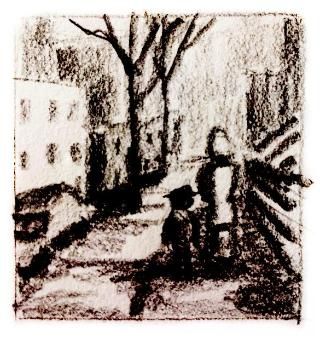Asher Lev Discussion Guide: Part 3

Chapters 6 through 9
Dr. David McNutt (Core Studies)
In these chapters, Asher’s development as an artist expands rapidly through his encounters with new art forms and his mentorship under Jacob Kahn. Meanwhile, his relationship with his parents, especially his father, becomes even more fractured.
- Asher’s relationship with his father, Aryeh, who he describes at one point as “an adversary,” complicates the narrative of the novel. In these chapters, we find repeated references to Asher’s failure to follow the command to “honor your father” as he pursues his artistic interests (164-5, 192), yet Aryeh also says that he is “ashamed of my own son.” (196). Is Asher a good son? Is Aryeh a good father?
- Asher’s mother, Rivkeh, stands tentatively between her husband and her son (196). She is often the object of Aryeh’s anger at what is happening to their son. Meanwhile, she enables Asher’s artistic interest, but she doesn’t fully celebrate his gift either. How might she embody the broader relationship between art and faith?
- When Asher visits the museum with his mother, they view and later discuss paintings of Jesus. Why do you think Asher is so attracted to depictions of Christ?
- In her discussion with Asher about the paintings of Jesus, Rivkeh says that Jesus could not have been the Messiah because of the presence of suffering in the world: “Would there be so much suffering if the moshiach had really come?” (170) How would you respond to her?
- As part of his development as an artist, Asher draws images of the crucified Christ (171-2) as well as nude women (172, 230), forms that are anathema to the Jewish community. Do you think that it was right for Asher to draw these forms?
- In a visit to the Rebbe’s office, Asher meets Jacob Kahn, a Jewish artist who agrees to take him on as a student. Kahn believes that an artist bears no responsibility to anyone or anything other than their art (218). Do you agree?
- Look at an image of Picasso’s Guernica (194-7, 198-200); read Matthew 2:13-18 (199-200). What do you notice?
- In Jacob Kahn’s studio, Asher meets Anna Schaeffer, a gallery owner who represents the art world, which is described as a “tradition” and a “religion” (213). Is art a religion?
- Marc Chagall is often mentioned in the novel, but Anna Schaeffer mentions three other artists – Chaim Soutine, Amedeo Modigliani, and Jules Pascin (208) – each of whom suffered in different ways, as later referenced in the cruel note from Asher’s classmate (239). Why do you think Potok mentions these Jewish artists?
- At the end of Chapter 9, Asher tells his mother “Have a safe journey,” which she had said many times to her husband before his travels. How has Asher’s relationship with his parents changed by this point?
